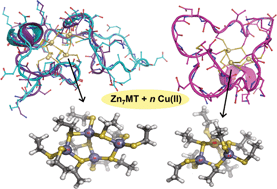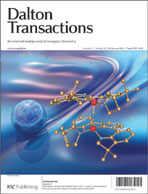Metallothionein Zn2+- and Cu2+-clusters from first-principles calculations†
Abstract
Detailed electronic structures of Zn(II) and Cu(II) clusters from metallothioneins (MT) have been obtained using density functional theory (DFT), in order to investigate how oxidative stress-caused Cu(II) intermediates affect Zn-binding to MT and cooperatively lead to Cu(I)MT. The inferred accuracy is ∼0.02–0.03 Å for metal–thiolate bond lengths for the models that are the most realistic MT models so far studied by DFT. We find terminal Zn–S and Cu–S bond lengths of 2.35–2.38 Å and 2.30–2.34 Å, whereas bridging M–S bonds are 0.05–0.11 Å longer. This electronic effect is also reflected in changes in electron density on bridging sulfurs. Various imposed backbone constraints quantify the sensitivity of cluster electronic structure towards


 Please wait while we load your content...
Please wait while we load your content...